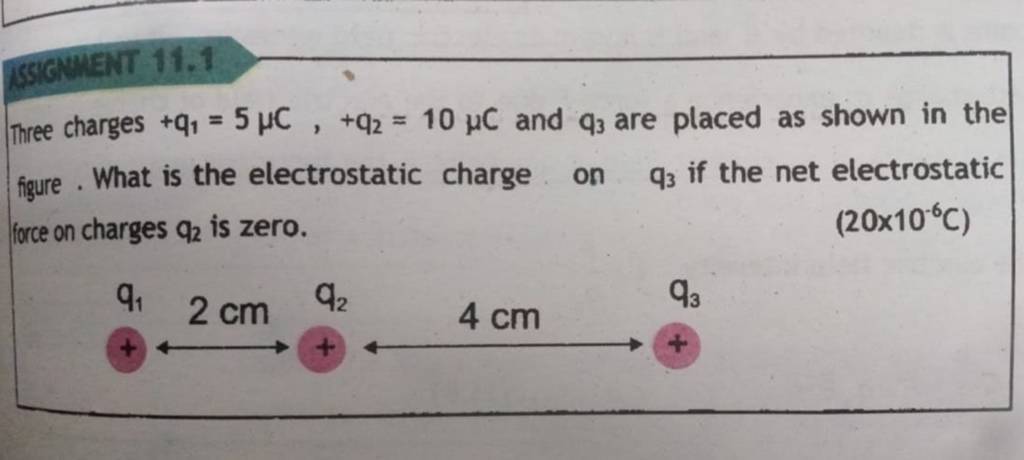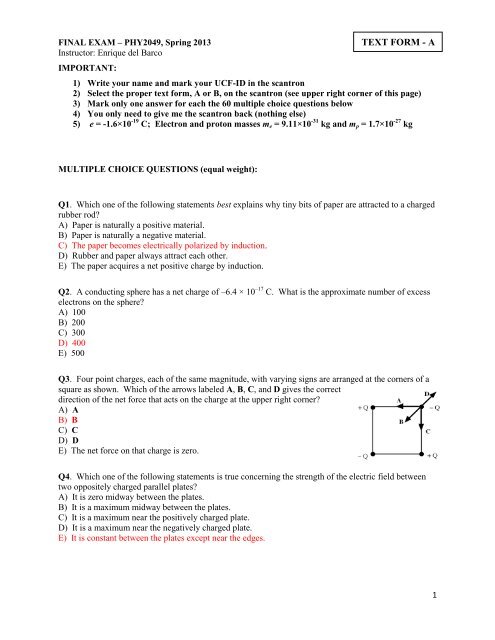In the figure particle 1 of charge q1 = 0.98 μC and particle 2 of charge q2 = -3.01 μC, are held at separation L = 9.0 cm on an x axis. If particle 3 of unknown charge q3 is to be located such that the net electrostatic force on it from particles 1 and 2 is zero, what must be the (a)x and (b)y coordinates of particle 3?
Water-soluble extracellular vesicle probes based on conjugated oligoelectrolytes | Science Advances
Science Physics Physics questions and answers In the figure particle 1 of charge q1=1.03μC and particle 2 of charge q2=−3.07μC. are held at separation L=10.5 cm on an x axis.

Source Image: yumpu.com
Download Image
In the figure particle 1 of charge q1 (at origin) and particle 2 of charge q2 = 3q1, are held at separation L on an x axis. If particle 3 of unknown charge q3 is to be located such that the net electrostatic force on it from particles 1 and 2 is zero, what must be the (a) x and (b) y coordinates of particle 3? Figure: http://i.imgur.com/y8YxK1P.gif

Source Image: chegg.com
Download Image
in the figure, the particles have charges q1=-q2=890nC and q3 = -q4 = 95 nC, and distance a = 5.1 cm. What are the (a) x and (b) y components of the Jun 6, 2023answer answered In the figure particle 1 of charge q1 = 0.95 μC and particle 2 of charge q2 = -2.99 µC, are held at separation L = 9.8 cm on an x axis. If particle 3 of unknown charge q3 is to be located such that the net electrostatic force on it from particles 1 and 2 is zero, what must be the (a)x and (b)y coordinates of particle 3?
![Fundamental Reactions] Why is the unit vector r̂ pointing opposite to the Electric Force? : r/PhysicsStudents](https://preview.redd.it/who8fgh2xup91.jpg?auto=webp&s=8fc4023e6a6915522b9c1a3250c54dd3a8cb08a5)
Source Image: reddit.com
Download Image
In The Figure Particle 1 Of Charge Q1
Jun 6, 2023answer answered In the figure particle 1 of charge q1 = 0.95 μC and particle 2 of charge q2 = -2.99 µC, are held at separation L = 9.8 cm on an x axis. If particle 3 of unknown charge q3 is to be located such that the net electrostatic force on it from particles 1 and 2 is zero, what must be the (a)x and (b)y coordinates of particle 3? The charges and coordinates of two charges particles held fixed in an xy plane are q1 = +3.0µC, x1 = 3.5cm, y1 = 0.50cm, and q2 = -4.0µC, x2 = -2.0cm, y2 = 1.5cm. … Particle 1 of charge +q and particle 2 of charge +4.00q are held at separation L = 9.00cm on an x axis. If particle 3 of charge q3 is to be located such that the three particles
Fundamental Reactions] Why is the unit vector r̂ pointing opposite to the Electric Force? : r/PhysicsStudents
2024 Find step-by-step Physics solutions and your answer to the following textbook question: In the given figure, particle 1 (of charge q1 ) and particle 2 (of charge q2 ) are fixed in place on an x axis, .8.00 cm apart. Three charges +q1=5μC,+q2=10μC and q3 are placed as shown in the figur..

Source Image: askfilo.com
Download Image
Symmetry | Free Full-Text | Liouville Theory for Fully Analytic Studies of Transverse Beam Dynamics in Laser-Plasma Ion Accelerators 2024 Find step-by-step Physics solutions and your answer to the following textbook question: In the given figure, particle 1 (of charge q1 ) and particle 2 (of charge q2 ) are fixed in place on an x axis, .8.00 cm apart.

Source Image: mdpi.com
Download Image
Water-soluble extracellular vesicle probes based on conjugated oligoelectrolytes | Science Advances In the figure particle 1 of charge q1 = 0.98 μC and particle 2 of charge q2 = -3.01 μC, are held at separation L = 9.0 cm on an x axis. If particle 3 of unknown charge q3 is to be located such that the net electrostatic force on it from particles 1 and 2 is zero, what must be the (a)x and (b)y coordinates of particle 3?

Source Image: science.org
Download Image
in the figure, the particles have charges q1=-q2=890nC and q3 = -q4 = 95 nC, and distance a = 5.1 cm. What are the (a) x and (b) y components of the In the figure particle 1 of charge q1 (at origin) and particle 2 of charge q2 = 3q1, are held at separation L on an x axis. If particle 3 of unknown charge q3 is to be located such that the net electrostatic force on it from particles 1 and 2 is zero, what must be the (a) x and (b) y coordinates of particle 3? Figure: http://i.imgur.com/y8YxK1P.gif

Source Image: homework.study.com
Download Image
TEXT FORM – A – UCF Physics Particle 1 , with charge q1, is fixed in place at distance d. Particle 2, with charge q2, can be moved along the x axis. Another figure gives the net electric potential V V at the origin due to the particles as a function of the x x coordinate of particle 2 .

Source Image: yumpu.com
Download Image
A particle having charge q1 exerts electrostatic force F on charge q2 a.. Jun 6, 2023answer answered In the figure particle 1 of charge q1 = 0.95 μC and particle 2 of charge q2 = -2.99 µC, are held at separation L = 9.8 cm on an x axis. If particle 3 of unknown charge q3 is to be located such that the net electrostatic force on it from particles 1 and 2 is zero, what must be the (a)x and (b)y coordinates of particle 3?
Source Image: askfilo.com
Download Image
Two charged particles are shown in the above figure (a). Particle 1, with charge q_1, is fixed in place distance d. Particle 2, with charge q_2, can be moved along the x The charges and coordinates of two charges particles held fixed in an xy plane are q1 = +3.0µC, x1 = 3.5cm, y1 = 0.50cm, and q2 = -4.0µC, x2 = -2.0cm, y2 = 1.5cm. … Particle 1 of charge +q and particle 2 of charge +4.00q are held at separation L = 9.00cm on an x axis. If particle 3 of charge q3 is to be located such that the three particles

Source Image: toppr.com
Download Image
Symmetry | Free Full-Text | Liouville Theory for Fully Analytic Studies of Transverse Beam Dynamics in Laser-Plasma Ion Accelerators
Two charged particles are shown in the above figure (a). Particle 1, with charge q_1, is fixed in place distance d. Particle 2, with charge q_2, can be moved along the x Science Physics Physics questions and answers In the figure particle 1 of charge q1=1.03μC and particle 2 of charge q2=−3.07μC. are held at separation L=10.5 cm on an x axis.
in the figure, the particles have charges q1=-q2=890nC and q3 = -q4 = 95 nC, and distance a = 5.1 cm. What are the (a) x and (b) y components of the A particle having charge q1 exerts electrostatic force F on charge q2 a.. Particle 1 , with charge q1, is fixed in place at distance d. Particle 2, with charge q2, can be moved along the x axis. Another figure gives the net electric potential V V at the origin due to the particles as a function of the x x coordinate of particle 2 .